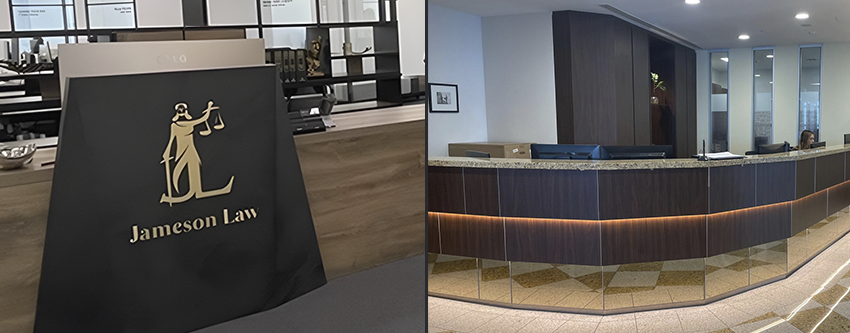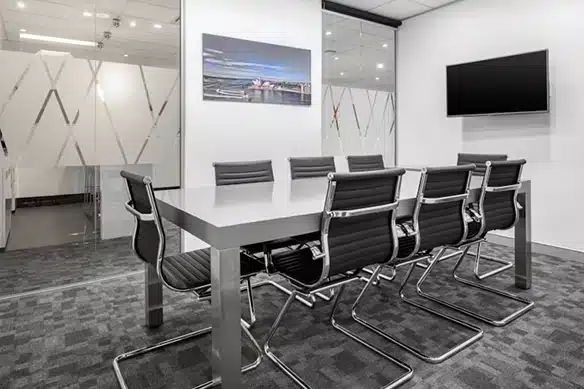Navigating the Personal Injury Commission’s procedural directions can be daunting for many claimants. These directions play a crucial role in the smooth progression of your case.
At Jameson Law, we understand the complexities involved and are here to guide you through the process. This post will break down the key aspects of Personal Injury Commission procedural directions, helping you stay on track with your claim.
What is the Personal Injury Commission in NSW?
Establishment and Purpose
The Personal Injury Commission (PIC) in NSW is a specialised tribunal that resolves disputes related to workplace injuries and motor accidents. The NSW government established the PIC on 1 March 2021 to streamline the claims process and provide fair, quick, and cost-effective resolutions.
Jurisdiction and Types of Claims
The PIC handles two main types of claims:
- Workers Compensation: These claims involve disputes about workplace injuries, including physical injuries, psychological injuries, and occupational diseases. The PIC addresses issues such as weekly payments, medical expenses, and permanent impairment assessments.
- Compulsory Third Party (CTP): These claims relate to motor vehicle accidents and cover disputes about liability, treatment expenses, and damages for more serious injuries.
The Commission’s jurisdiction extends across NSW, and it operates under the Personal Injury Commission Act 2020. This Act outlines the PIC’s powers and procedures, ensuring a consistent approach to dispute resolution.
Key Stakeholders in the Process
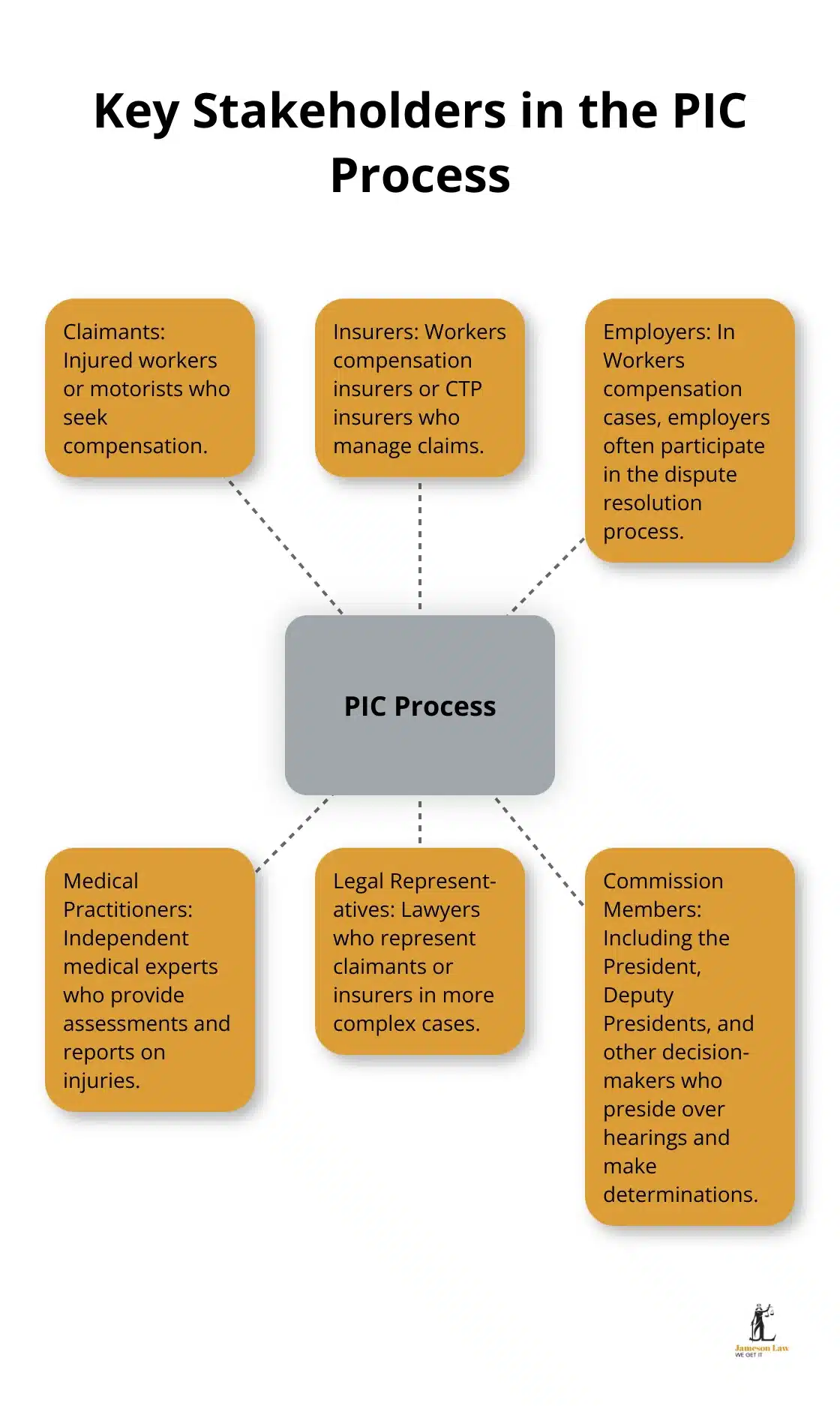
Several parties play important roles in the PIC process:
- Claimants: Injured workers or motorists who seek compensation.
- Insurers: Workers compensation insurers or CTP insurers who manage claims.
- Employers: In Workers compensation cases, employers often participate in the dispute resolution process.
- Medical Practitioners: Independent medical experts who provide assessments and reports on injuries.
- Legal Representatives: Lawyers who represent claimants or insurers in more complex cases.
- Commission Members: Including the President, Deputy Presidents, and other decision-makers who preside over hearings and make determinations.
Practical Considerations
When you engage with the PIC, it’s important to:
- Act promptly: The PIC has strict timeframes for lodging applications and responding to directions. Missing these deadlines can seriously impact your claim.
- Gather comprehensive evidence: The strength of your case often depends on the quality of your evidence. This includes medical reports, witness statements, and financial records.
- Understand the process: Familiarise yourself with the PIC’s procedures, including how to lodge applications and what to expect during hearings.
- Seek expert advice: Given the complexity of personal injury law, it’s often beneficial to consult with experienced legal professionals. (Jameson Law specialises in navigating the PIC process and can provide tailored advice for your specific situation.)
The PIC’s goal is to resolve disputes efficiently and fairly. Understanding its purpose, jurisdiction, and key stakeholders will equip you to navigate your claim successfully. As we move forward, let’s explore the specific procedural directions that guide the PIC’s operations and how they impact your claim.
Understanding Procedural Directions in the Personal Injury Commission
Definition and Purpose
Procedural directions are specific instructions issued by the Personal Injury Commission (PIC) to guide the conduct of proceedings. These directions streamline the claims process, ensure fairness, and promote efficiency in dispute resolution. The PIC provides a list of expected supporting documents to be submitted by parties, and the order in which they should be presented.
Types of Procedural Directions
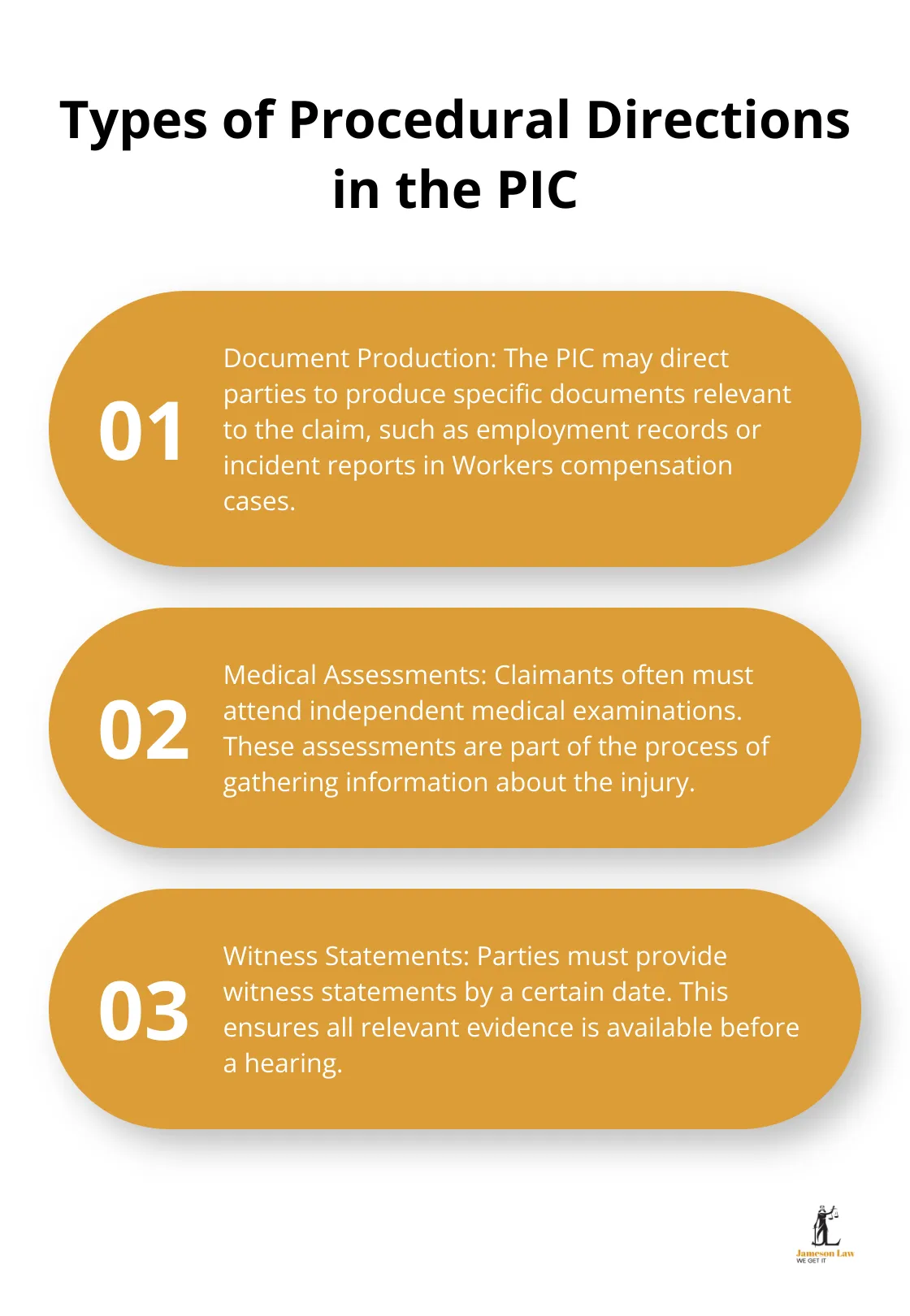
The PIC issues various procedural directions depending on the nature of the claim and the stage of proceedings. Common directions include:
- Document Production: The PIC may direct parties to produce specific documents relevant to the claim. (For example, in a Workers compensation case, an employer might need to provide employment records or incident reports.)
- Medical Assessments: Claimants often must attend independent medical examinations. These assessments are part of the process of gathering information about the injury.
- Witness Statements: Parties must provide witness statements by a certain date. This ensures all relevant evidence is available before a hearing.
- Expert Reports: The PIC frequently directs the submission of expert reports, such as medical opinions or accident reconstruction analyses.
- Teleconferences: Parties might need to participate in teleconferences to discuss the progress of the claim and resolve any preliminary issues.
Timeframes and Compliance
Procedural directions come with specific deadlines that parties must strictly adhere to. For instance, the PIC might direct that medical reports be submitted within 28 days of the direction being issued. Failing to meet these deadlines can have serious consequences, including potential dismissal of the claim or unfavourable inferences being drawn.
Challenging Procedural Directions
While compliance is important, there may be instances where a procedural direction is impractical or impossible to follow. In such cases, it’s vital to communicate with the PIC promptly. The Commission may grant extensions or modify directions if there are valid reasons.
For example, if a claimant must attend a medical assessment, but is physically unable to travel due to their injuries, the PIC may consider alternative arrangements, such as a home visit by the medical expert or a video consultation.
The Impact of COVID-19
The COVID-19 pandemic has led to significant changes in how the PIC issues and follows procedural directions. The PIC has adapted by increasing the use of virtual hearings and electronic document submissions.
These changes have made it more important than ever to have reliable technology and a clear understanding of digital procedures. (Legal professionals have had to quickly adapt to these new digital requirements to ensure their clients’ cases progress smoothly.)
As we move forward, it’s clear that understanding and complying with procedural directions is key to a successful claim. The next section will explore the specific steps you can take to ensure compliance with these important directives.
Why Compliance Matters in Personal Injury Claims
The Importance of Following Procedural Directions
The Personal Injury Commission (PIC) in NSW takes a strict approach to compliance with procedural directions. This approach ensures fairness and efficiency in the dispute resolution process. Adherence to these directions is not just a formality-it forms a critical aspect of your claim’s success.
Consequences of Non-Compliance
Failure to follow procedural directions can result in severe consequences. For example, the NSW Personal Injury Commission Medical Review Panel has revoked a Medical Assessor’s Certificate on the basis of the Claimant’s reported evidence. This can result in a loss of potential compensation and additional legal costs.
In another instance from the NSW Workers Compensation Commission (now part of the PIC), a claimant’s weekly payments were reduced due to non-compliance with a direction to attend a medical examination. The financial impact was significant, with the claimant losing several weeks of income support.
Practical Strategies for Compliance
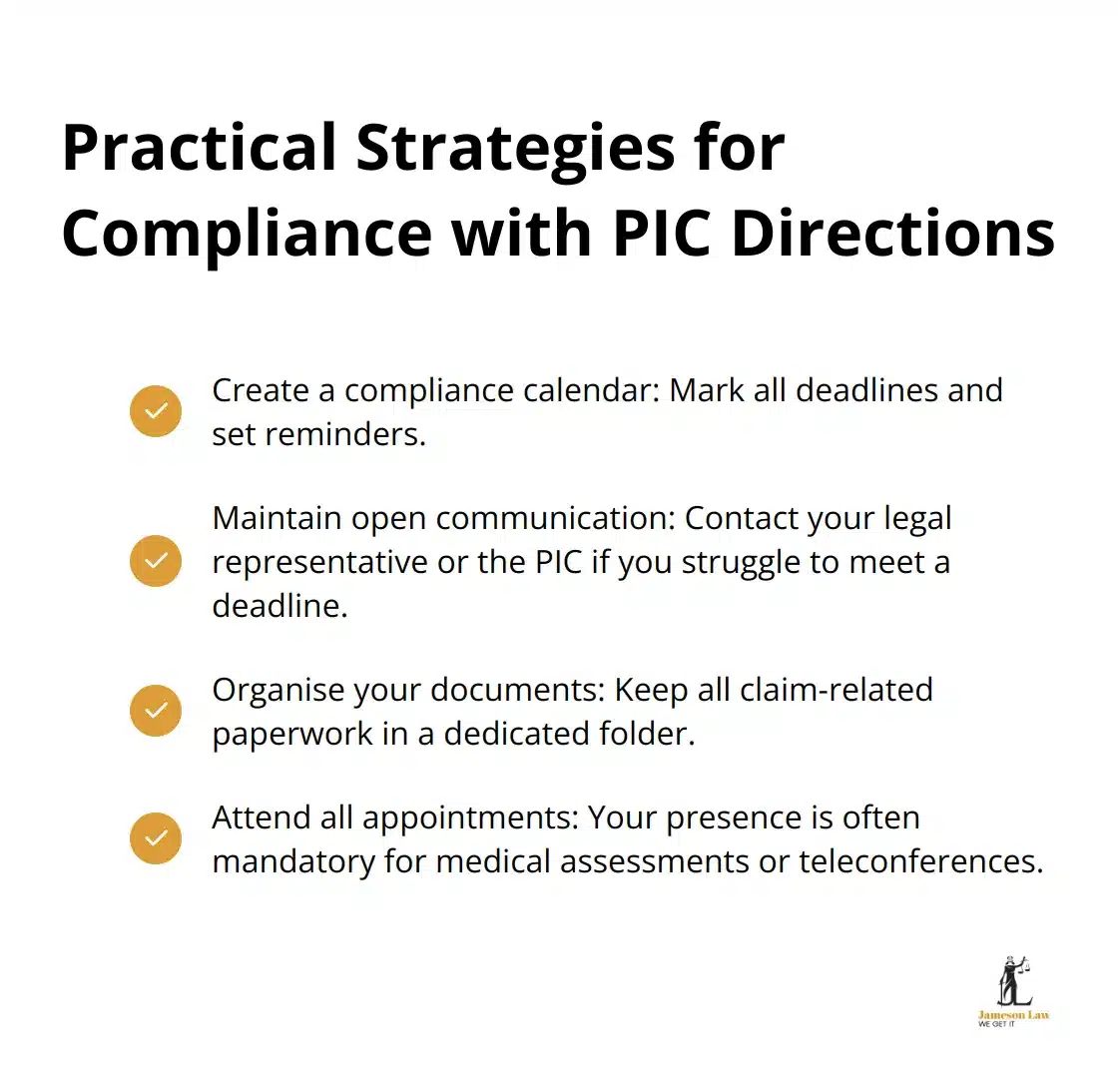
To avoid these pitfalls, you can implement these practical strategies:
- Create a compliance calendar: Mark all deadlines and set reminders at least a week before each due date. This simple step can prevent last-minute rushes and missed deadlines.
- Maintain open communication: If you struggle to meet a deadline, contact your legal representative or the PIC immediately to discuss your options. (Don’t wait until the last minute to seek help.)
- Organise your documents: Keep all claim-related paperwork in a dedicated folder, both physical and digital. This organisation makes it easier to respond quickly to directions for document production.
- Attend all appointments: Your presence is often mandatory, whether it’s a medical assessment or a teleconference. Missing these can lead to adverse inferences or delays in your claim.
Handling Compliance Challenges
There may be times when you find it difficult or impossible to comply with a direction. In such cases, you should act promptly:
- Notify the PIC immediately: Explain your situation and request an extension or alternative arrangement. The PIC may accommodate you if you have a valid reason and communicate early.
- Provide supporting evidence: If illness or unforeseen circumstances prevent compliance, obtain documentation (e.g., a doctors certificate) to support your request for leniency.
- Seek legal advice: If you’re unsure about how to proceed, consult with a legal professional experienced in PIC matters. They can guide you on the best course of action and help you communicate effectively with the Commission.
The PIC’s procedural directions streamline the claims process and ensure fair outcomes. You significantly improve your chances of a successful claim when you understand their importance and take proactive steps to comply. In the world of personal injury claims, diligence and timely action are your strongest allies.
Final Thoughts
Personal Injury Commission procedural directions serve as a roadmap for claimants and their representatives. These instructions guide parties through the complex terrain of personal injury law, contributing to a more efficient and fair process for everyone involved. Each direction plays a vital role in building a comprehensive picture of your case, ensuring decision-makers have all the necessary information to make informed and just determinations.
Compliance with these directions is essential for the success of your claim. Failing to follow procedural directions can lead to serious consequences, including potential dismissal of your claim or unfavourable inferences. Diligent compliance, on the other hand, can streamline your case, potentially leading to quicker resolutions and better outcomes.
Navigating these procedural waters can challenge those unfamiliar with legal processes. Expert guidance becomes invaluable in such situations. Jameson Law specialises in guiding clients through the intricacies of personal injury claims (our team understands the nuances of Personal Injury Commission procedures and can provide the support you need to navigate them effectively).









